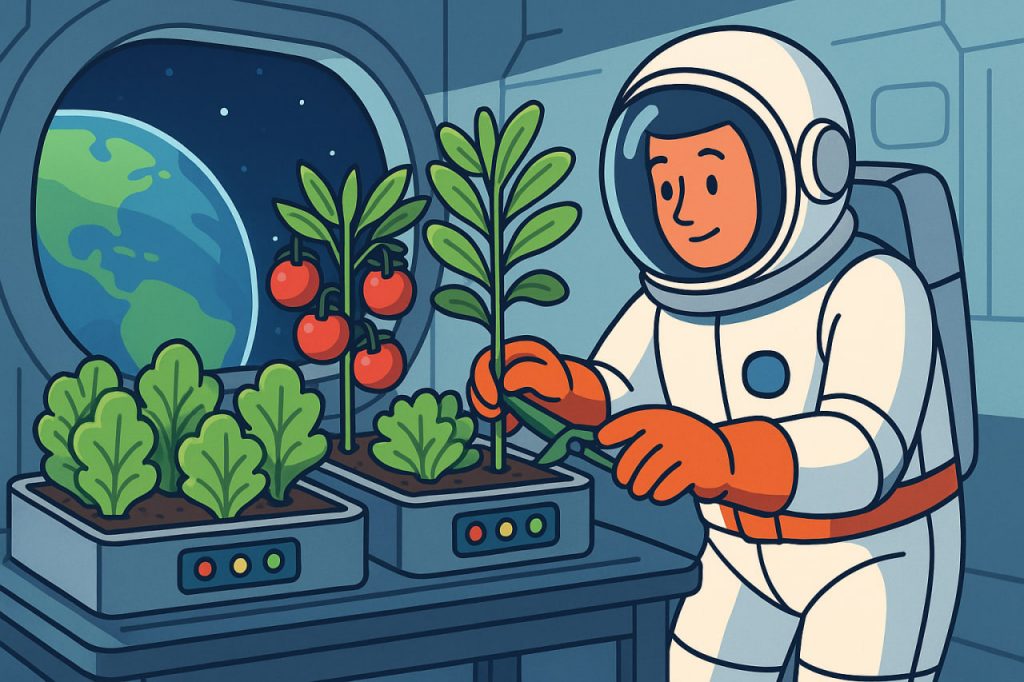Growing plants in space has become a crucial component of long-term space exploration. As humanity prepares for extended missions to the Moon, Mars, and beyond, sustainable food production in microgravity is no longer a theoretical challenge — it is a pressing engineering and biological frontier. The ability to grow crops in orbit supports crew nutrition, psychological well-being, oxygen regeneration, and closed-loop life support systems.
Why Space Agriculture Matters
Space stations and future planetary bases cannot rely entirely on resupply missions from Earth. Bioregenerative life support systems, which use plants to recycle air, water, and nutrients, are essential for autonomy in deep space. Additionally, fresh produce offers nutritional diversity and mental comfort for astronauts, especially during long-duration missions.
Growing plants on Earth relies on gravity to guide root growth (gravitropism), water flow, and air exchange. In microgravity, these processes behave differently, creating unique biological and technological challenges. Research in space agriculture contributes not only to spaceflight, but also to controlled environment agriculture (CEA) on Earth.
Challenges of Growing Plants in Microgravity
In the absence of gravity, root orientation becomes randomized, affecting nutrient uptake and development. Water distribution is also irregular, as fluids tend to form floating blobs, causing over-saturation or desiccation of roots. Additionally, carbon dioxide may accumulate around plant leaves without convection currents, inhibiting photosynthesis.
Lighting conditions must also be artificially controlled using LED arrays to optimize photosynthetically active radiation (PAR). Plants often exhibit altered gene expression, requiring careful selection of varieties that can adapt to microgravity environments.
Technologies Enabling Space Farming
To overcome these issues, engineers have developed advanced hydroponic and aeroponic systems, which deliver nutrients directly to plant roots without soil. These systems are enclosed to regulate moisture, CO₂, and light. Veggie and Advanced Plant Habitat (APH) on the International Space Station (ISS) are examples of such systems.
Sensors and AI are now used to monitor plant health and optimize growth conditions remotely. The development of modular growth chambers allows researchers to experiment with different crops simultaneously under varying conditions. Some systems recycle moisture from plant transpiration, contributing to closed ecological loops.
Successful Space-Grown Crops
Since 2015, astronauts aboard the ISS have successfully grown and eaten lettuce, radishes, zinnias, mustard greens, chili peppers, and wheat. These experiments have shown that many terrestrial plants can complete their life cycle in orbit. Crops are chosen based on growth rate, nutritional density, and compact morphology.
In 2021, NASA astronauts harvested space-grown red romaine lettuce and chili peppers, marking a milestone for space farming. Ongoing studies test whether seeds harvested in microgravity retain viability and whether successive generations can adapt genetically.
Future of Orbital Agriculture
The next step involves scaling up from small experiments to larger bioreactors and space greenhouses. Missions to Mars will require more diverse crops and autonomous systems capable of operating with minimal human intervention. Research on regolith-based agriculture, using lunar or Martian soil simulants, is already underway.
Private companies and national space agencies are investing in space farming technologies, not only for survival, but also as potential commercial ventures for producing rare medicinal compounds or high-value crops in orbit.
Conclusion
Space agriculture represents a convergence of biology, engineering, and sustainability. As humanity moves beyond Earth, the ability to grow plants in orbit will be a cornerstone of survival and self-reliance. Breakthroughs in microgravity agriculture not only prepare us for life in space, but also inspire innovation in Earth-based food systems.
Glossary
- Microgravity — an environment with very low gravitational force, as experienced in orbit.
- Hydroponics — a method of growing plants without soil, using nutrient-rich water.
- Aeroponics — growing plants in air or mist environments with roots suspended.
- Photosynthetically Active Radiation (PAR) — wavelengths of light used by plants for photosynthesis.
- Bioregenerative life support — systems that recycle resources like oxygen and water using plants and microorganisms.
- Veggie — a plant growth system on the ISS used for growing edible crops.
- Controlled Environment Agriculture (CEA) — farming in fully controlled indoor systems.



I like this blog very much, Its a really nice position to read and receive information. “‘Taint’t worthwhile to wear a day all out before it comes.” by Sarah Orne Jewett.
Its like you read my thoughts! You seem to understand so much about this, such as you wrote the ebook in it or something. I think that you could do with some percent to pressure the message house a little bit, but other than that, this is great blog. An excellent read. I’ll certainly be back.